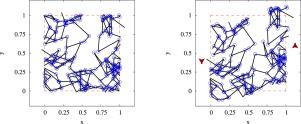局部剪切刚度在弹性细丝随机网的弯曲和拉伸主导状态之间切换
IF 3.8
3区 工程技术
Q1 MECHANICS
International Journal of Solids and Structures
Pub Date : 2025-07-28
DOI:10.1016/j.ijsolstr.2025.113576
引用次数: 0
摘要
研究了随机弹性网络中各组成部分刚度的变化规律。由于局部剪切模量(建模为交联细丝之间旋转的能量成本)的变化,我们发现较小和较高的网络剪切刚度之间的急剧转变,类似于先前在拉伸网络中发现的情况。这种转变类似于在没有局部剪切刚度的网络中观察到的非仿射到仿射的转变。我们发现,在过渡状态下,总网络刚度的剪切分量出现峰值,拉伸分量增加,直至达到平台,本质上导致了过渡。通过对实测网络剪切刚度进行适当的缩放,我们发现数据在一条曲线上有很好的折叠。在过渡之外,在非常大的弯曲和剪切组合刚度状态下,我们确定了网络的显着硬化。我们还研究了各向异性网络,发现向更强网络的过渡变得更加强调,并且在过渡期间总网络剪切模量的剪切分量变得更高。我们建议网络,特别是各向异性网络,可以通过使用可变交联组件调整局部剪切模量来在较低和较高的整体剪切刚度之间进行调整。本文章由计算机程序翻译,如有差异,请以英文原文为准。

Local shear stiffness switches between bending- and stretch-dominated regimes of a random net of elastic filaments
Transitions in a random elastic network are investigated as a function of the stiffness of its constituents. As the local shear modulus, modelled as an energy cost of rotation among cross-linked filaments, is varied, we find a sharp transition between smaller and higher network shear stiffness, similar to that previously found for stretched networks. This transition is similar to the non-affine to affine transition observed in networks without local shear stiffness. We discover that, in the transition regime, the shear component of the total network stiffness shows a peak, and the stretch component increases until reaching a plateau, essentially causing the transition. With a suitable re-scaling of the measured network shear stiffness, we find a good collapse of the data on a single curve. Beyond the transition, in the very large combined bending and shear stiffness regime, we identify a marked stiffening of the network. We also investigate anisotropic networks to find that the transition to a stronger network becomes more emphasized, and the shear component of the total network shear modulus becomes higher during the transition. We suggest that networks, specially anisotropic ones, can be tuned between lower and higher overall shear stiffness by adjusting the local shear modulus using variable cross-linking components.
求助全文
通过发布文献求助,成功后即可免费获取论文全文。
去求助
来源期刊
CiteScore
6.70
自引率
8.30%
发文量
405
审稿时长
70 days
期刊介绍:
The International Journal of Solids and Structures has as its objective the publication and dissemination of original research in Mechanics of Solids and Structures as a field of Applied Science and Engineering. It fosters thus the exchange of ideas among workers in different parts of the world and also among workers who emphasize different aspects of the foundations and applications of the field.
Standing as it does at the cross-roads of Materials Science, Life Sciences, Mathematics, Physics and Engineering Design, the Mechanics of Solids and Structures is experiencing considerable growth as a result of recent technological advances. The Journal, by providing an international medium of communication, is encouraging this growth and is encompassing all aspects of the field from the more classical problems of structural analysis to mechanics of solids continually interacting with other media and including fracture, flow, wave propagation, heat transfer, thermal effects in solids, optimum design methods, model analysis, structural topology and numerical techniques. Interest extends to both inorganic and organic solids and structures.

 求助内容:
求助内容: 应助结果提醒方式:
应助结果提醒方式:


